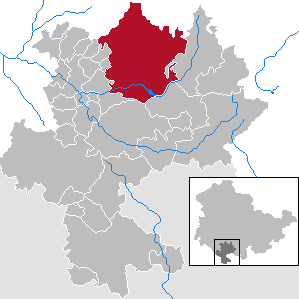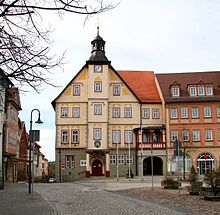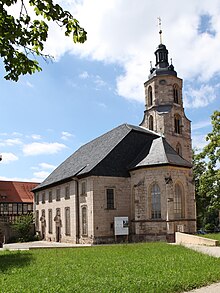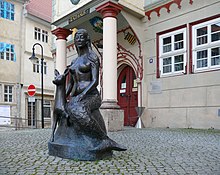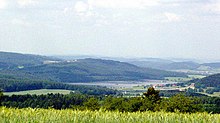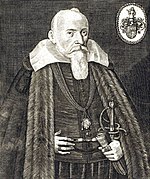Schleusingen
| coat of arms | Germany map | |
|---|---|---|

|
Coordinates: 50 ° 31 ' N , 10 ° 45' E |
|
| Basic data | ||
| State : | Thuringia | |
| County : | Hildburghausen | |
| Height : | 372 m above sea level NHN | |
| Area : | 125.59 km 2 | |
| Residents: | 10,930 (Dec. 31, 2019) | |
| Population density : | 87 inhabitants per km 2 | |
| Postal code : | 98553 | |
| Area code : | 036841 | |
| License plate : | HBN | |
| Community key : | 16 0 69 043 | |
| LOCODE : | DE ZGJ | |
| City structure: | Core city and 17 districts | |
City administration address : |
Markt 9 98553 Schleusingen |
|
| Website : | ||
| Mayor : | André Henneberg | |
| Location of the town of Schleusingen in the Hildburghausen district | ||
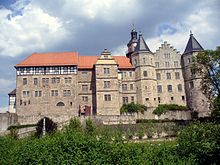
Schleusingen is a Thuringian town on the southern slope of the Thuringian Forest in the Frankish coined Hildburghausen .
geography
The town of Schleusingen in the Henneberger Land got its name from the river Schleuse , which runs south of the city center. The core city itself is located on the Nahe , a tributary of the lock. Coming from the north, the alder flows into the Nahe in Schleusingen. The 850 m high Adlersberg (Thuringian Forest) lies in the area of the city.
City structure
In addition to the core city, the town of Schleusingen includes a further seventeen districts:
- Altendambach
- Breitenbach
- Erlau
- Fischbach
- Geisenhöhn
- Gethles
- Gottfriedsberg
- Heckengereuth
- Hirschbach
- Close to the bottom
- Oberrod
- Rappelsdorf
- Ratchet
- Schleusingerneundorf
- Silbach
- St. Kilian
- Waldau
In the population, terms for residential areas such as Upper and Lower Town, Schmuckplatz, Weißer Berg, Hirtengrund, Kalkrangen, Sonneneck, Rubetal , etc. are also used.
history
Schleusingen was first mentioned in a document in 1232 as villa Slusungen . Count Poppo VII von Henneberg had the Bertholdsburg built as an official seat and fortification in the period from 1226 to 1232. In 1274 the county of Henneberg was divided into three lines. The Bertholdsburg then became the residence of the Schleusinger line. Schleusingen experienced its first fire disaster in 1353, and other city fires in 1679, 1765, 1773 and 1876 destroyed entire districts.
Schleusingen received its town charter in 1412, but not market charter until 1533 . Count Wilhelm IV founded a barefoot monastery on the outskirts of the city in 1502 , which belonged to the Saxon Franciscan Province ( Saxonia ). During the unrest in the Peasants' War in spring 1525, the inmates, documents and valuables from the neighboring Veßra and Trostadt monasteries were brought to safety in Schleusingen and Bertholdsburg. The Reformation was introduced in 1544 . The aegidia chapel of St. John's Church was the burial place of the Counts of Henneberg and Elisabeth of Brandenburg in 1566 . The barefoot monastery, which was closed after the Reformation in 1545, became state property and was used as a school from 1560. This was inaugurated as a grammar school on June 7, 1577 and still exists today under the name Hennebergisches grammar school "Georg Ernst" . Schleusingen was the seat of the Counts of Henneburg until 1583. After the death of Count Georg Ernst , with whom his line died out in the male line, Schleusingen came to the Saxon dukes of the Ernestine and Albertine lines, initially under joint administration. From 1500 to 1806 Schleusingen belonged to the Franconian Empire .
From 1621 to 1622 there was a kipper mint in the city , in which interim coins (kipper coins) for Henneberg were struck under the mint master Barthel Eisendraht. These were cruiser pieces and so-called Kippertaler at 40 groschen.
Schleusingen gained economic importance through the influx of glassmakers from the Hessian Gläsnerbund and the Spessart . The rich wood stocks in the mountainous hinterland of the Thuringian Forest formed the basis of numerous glassworks and important Thuringian porcelain manufacturers until the 19th century . During the Thirty Years' War , when the first imperial troops arrived in 1634 , the city commander Ludwig Ernst Marschall was able to save the city from the plundering and destruction by the Croatians of the dreaded General Isolani with great negotiating skills . However, these used Schleusingen as winter quarters and moved down the Werra, pillaging and pillaging to the Kuppenrhön .
In the Saxon partition treaty of 1660, the town and office of Schleusingen fell to Sachsen-Zeitz . In 1709 the construction of a bathhouse at Wilhelmsbrunnen began. After the Sachsen-Zeitz line was extinguished, Schleusingen fell to the Electorate of Saxony . The St. John's Church was rebuilt in 1725. The town church was built in the baroque style.
From 1815 Schleusingen belonged to Prussia and in 1816 was raised to the district seat of the Schleusingen district. The art roads to Suhl, Hildburghausen, Burgstrasse, Königstrasse, Veßra Abbey and Ilmenau were built in 1817. The years 1846 and 1847 were years of severe famine. During the bourgeois revolution of 1848 there was a large popular assembly in Schleusingen and riots in the market. A road to Eisfeld was built in 1849. The grammar school was rebuilt from 1870 to 1874.
In 1888 the Schleusingen – Themar railway was built , the Rennsteigbahn to Ilmenau in 1904 and the Friedbergbahn to Suhl in 1911. Since the late 19th century, the city developed into a resort . In the 19th century the Jewish community had grown so much that it inaugurated a new synagogue in 1881 on the corner of Bertholdstrasse and Walchstrasse . It was destroyed by the Nazis during the November pogrom in 1938 , as a memorial plaque installed in 1988 commemorates. The 30 or so parishioners who remained in 1932 were driven into emigration or in 1942 deported to the extermination camps. The last burial took place in the Jewish cemetery in Judengrund in 1937.
During the Second World War , 1612 women and men, mainly from the Soviet Union and prisoners of war from the countries occupied by Germany, had to do forced labor : in agriculture and forestry, in drawing and stamping works , in the Adam Heinz Glashütte Friedrichswerk company , in the L. F. Ansorg company and in the railway maintenance office. A memorial in the cemetery on Ilmenauer Strasse commemorates 44 deceased inmates of the Römhild “ labor education camp ” .
Schleusingen was occupied in 1945 first by American and later by Soviet troops. The Schleusingen district was incorporated into the state of Thuringia and renamed the Suhl district in 1946 . The city belonged to the Hildburghausen district for two years from 1950 to 1952 , but then returned to the Suhl district. The Schleusingen District Court was dissolved in 1951. After the fall of the Wall , Schleusingen was incorporated into the Hildburghausen district in 1994.
The NPD repeatedly tried to gain a foothold in the town, but met with rejection from the citizens. The climax was in 2007 when an NPD functionary and neo-Nazi tried to join the Schleusingen volunteer fire department . The local fire department then submitted a list of 42 people who would leave in this case. The mayor rejected the request of the NPD functionary. This case of moral courage made the place known throughout Germany.
The core town of Schleusingen had 4122 inhabitants in 2013.
Incorporations
- Fischbach on March 1, 1970
- Geisenhöhn and Gottfriedsberg on April 1, 1974
- Gethles, Ratscher and Heckengereuth on February 22, 1994
- Rappelsdorf on June 1, 1996
- Nahetal-Waldau and St. Kilian (Schleusingen was previously the fulfilling municipality for St. Kilian) on July 6, 2018
Population development
(respective territorial status)
Development of the population (from 1960 on each December 31st) :
|
|
|
politics
City council
The town council of Schleusingen consists of 24 elected members plus the mayor, who chairs the town council. The members of the city council are active in the following bodies: main committee, committee building / economy / order, culture committee, members of the supervisory board of the housing company Schleusingen and as members of the city of Schleusingen on the supervisory board of the Henneberg-Kliniken gGmbH Hildburghausen.
For the local elections on May 26, 2019 , the city council was elected for the first time in the city limits that have been in effect since July 6, 2018. Since then, the city council has been composed as follows:
| Party / list | Seats | +/- |
| FWS | 7th | + 4 |
| CDU | 7th | - 3 |
| SPD | 4th | + 2 |
| left | 2 | ± 0 |
| FWW | 2 | + 2 |
| active | 1 | - 1 |
| BZH | 1 | + 1 |
The SPD, Left and Active form a common faction in the current city council.
For the 2019 local elections, the far-right Bündnis-Zukunft-Hildburghausen (BZH) entered the city council for the first time . The FDP candidacy was unsuccessful.
mayor
- 1990 - June 2018: Klaus Brodführer (CDU)
- since November 2018: André Henneberg (Free Voting Association Schleusingen)
coat of arms
Blazon : “In blue, a growing silver gate castle made up of three round towers with red bell roofs, golden, padded, left-waving weather vanes, the flank towers joined in black halfway up, raised by black arched windows, the raised central tower with two low, black arched windows above a framed, open golden one Portal with a black, red-armored hen on a green three-mountain. "
The coat of arms essentially goes back to a town seal from 1430, the Mechthild, wife of Count Heinrich XI. von Henneberg , awarded to the city. The inclined beam from the Mechthild family coat of arms that still existed in Baden was later dropped. The coat of arms was given its current form in 1938.
Town twinning
- Since 1990 there has been a town partnership with the town of Plettenberg in the Sauerland (North Rhine-Westphalia) .
Culture and sights
Buildings
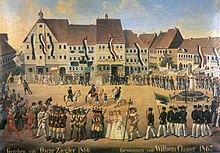
Sights include Bertholdsburg Castle , St. John's Church and the German School .
The Protestant Kreuzkirche is also worth seeing . The church is located in the north of the city at the cemetery. In 1454 a Heiligenkreuz chapel was built at this point, and in 1530 the cemetery was moved to this location. After it fell into disrepair after the Reformation, this Gottesackerkirche was built between 1600 and 1602, at that time with a small hexagonal tower with a death bell in the middle of the roof that had long since been dismantled. The organ from 1896 was expanded from 11 to 12 registers in 1949. The church was restored in the 2010s.
There is also the Hennebergische Gymnasium , founded in 1577 by Count Georg Ernst von Henneberg-Schleusingen , one of the oldest grammar schools in Germany.
Only a few kilometers south of the city center is the Ratscher dam , which was put into operation in 1983 and is used for flood protection and as a recreational area.
Remnants of the city fortifications are preserved in the form of pieces of wall and towers.
Museums
The Natural History Museum Schloss Bertholdsburg Schleusingen is located in Schloss Bertholdsburg .
City festival
The largest cultural event is the annual castle and town festival with the historic Abitaufe on Saturday morning. All high school graduates of the year are driven in decorated handcarts through the city center to the Elisabeth Fountain on the market square, where they are released from school life with a personal saying and a lavish fountain water baptism. Previously it went to the municipal post office, where every high school graduate received a telegram with the words “Abi passed. Sends money! ”Sent home.
dialect
Hennebergisch , a Main Franconian dialect, is spoken in Schleusingen and the surrounding area .
Economy and Transport
The largest employers in Schleusingen, each with around 250 employees, are the Thuringia container glass factory (since the end of 2011 a factory of Wiegand-Glashüttenwerke GmbH ) and the Thuringian Forest Rehabilitation Center with several social institutions. A large number of jobs in the MEGA shopping center are concentrated in the shops there. There are also industrial areas and numerous smaller companies and service providers. Schleusingen also has several supermarkets and numerous shops in the city center. The former hospital, part of the regioMed clinics , has been converted into a care facility.
The city of Schleusingen has had the lowest trade tax assessment rate (328) in the Hildburghausen district since 2015. This was lowered to 300 for 2018. The commercial areas in the city are well used.
Schleusingen has had a motorway connection to the A 73 Suhl - Coburg - Nuremberg since 2006 , which has also been continuously accessible to the south since 2008. The L 3247 (formerly Bundesstraße 247 ) ends at the L 3004 (formerly B 4 ) at the Schleusingen motorway exit . The L 3004 connects Schleusingen with Ilmenau (about 22 km northeast) and with Eisfeld (15 km southeast) and takes over the to the north Function of an alternative route for dangerous goods trucks that are not allowed to pass the tunnel chain on the A 71 . The L3247 heads northeast and connects Schleusingen with Suhl / Zella-Mehlis (15 km northeast) and Oberhof (22 km north).
At Schleusingen station , the Friedbergbahn (closed in 1997) branches off to Suhl from the Rennsteigbahn (closed in 1998). On the Rennsteigbahn, special steam locomotive trips are carried out irregularly by the association Dampfbahnfreunde Mittlerer Rennsteig. This association also plans museum traffic on the Friedbergbahn.
Schleusingen is a hub in the Werrabus GmbH network , which operates bus services in the Hildburghausen district . There are regular bus connections on lines 200 to Suhl and Hildburghausen (every hour on weekdays with increased frequency during rush hour, every two hours on weekends), 203 to Masserberg and 205 to Coburg . Other lines run at irregular intervals and without weekend traffic and the like. a. to Themar and Schleusingerneundorf .
Public safety, fire safety and health
In addition to the Schleusingen volunteer fire brigade as the base fire brigade of the Hildburghausen district, Schleusingen is also home to the rescue station of the Johanniter-Unfall-Hilfe eV regional association of Saalfeld-Südthüringen.
Personalities
sons and daughters of the town
- Count Berthold VII von Henneberg (1272–1340), ruling count
- Katharina von Henneberg (around 1334-1397) since 1347 Margravine of Meißen, Landgravine of Thuringia etc.
- Georg Ernst (1511–1583) last ruling Count of Henneberg, founder of the grammar school, founder of the alumnate
- Ortolph Fomann the Elder (1560–1634), philosopher and legal scholar
- Sebastian Franck (1606–1668), hymn poet
- Michael Franck (1609–1667), Protestant hymn poet
- Johann Kühn (also: Kuhn , 1619–1676), mathematician, university professor and dean
- Samuel Reyher (1635–1714), mathematician and astronomer
- Sylvius Friedrich von Frankenberg and Ludwigsdorff (1728–1815), politician, secret council and minister
- Albrecht Georg Walch (1736–1822), local researcher and principal at the grammar school from 1769 to 1822
- Johann Georg Lenz (1748–1832), mineralogist, mountain burr and professor of mineralogy at the University of Jena
- Adam Christian Gaspari (1752–1830), geographer, professor of history, geography and statistics
- Karl Christian Daniel Baurschmidt (1762–1837), superintendent in Osterrode am Harz and educator
- Albert von Dörnberg (1824–1915), member of the Reichstag and Landtag
- Gustav Heim (1879–1933), trumpeter and cornet player
- Renatus Hupfeld (1879–1968), Protestant theologian
- Volker Eckstein (1946–1993), actor
- Iris Gleicke (* 1964), politician (SPD)
People connected to the city
- Elisabeth von Braunschweig-Calenberg (1526–1566), Countess von Henneberg, buried in the Schleusingen Castle Church
- Valentin Boxberger (1539–1596), court official, bailiff and judge
- Joachim Zehner (1566–1612), theologian, founder of the “Zehnerschen Bibliothek”, which is now in the Natural History Museum at Schloss Bertholdsburg in Schleusingen
- Sebastian Abesser (1581–1638), Protestant theologian, 1610–1620 archdeacon in Schleusingen
- Johannes Pretten (1634–1708), theologian, pastor and superintendent in Schleusingen, lecturer in theology at grammar school
- Christoph Sonntag (1654–1717), Protestant theologian, 1680–1690 superintendent in Schleusingen
- Samuel Steurlin (1655–1725), physician and natural scientist
- Christian Juncker (1668–1714), historiographer and writer, 1696–1708 vice rector of Schleusingen grammar school
- Johann Christoph Schreiter (1770–1821), 1809–1815 archdeacon in Schleusingen, then professor of theology at Kiel University
- Aleksis Kivi (1834–1872), Finnish author of the play Bierfahrt nach Schleusingen (1866)
- Benno Koppenhagen (1867–1934), Jewish doctor and writer
- Siegfried Eggebrecht (1886–1984), Evangelical Lutheran superintendent
- Bernd Wolf (* 1955), CDU politician, has lived in the city since 1975
- Ralf Werneburg (* 1958) paleontologist and director of the Natural History Museum at Schloss Bertholdsburg
- Kerstin Möhring (* 1965), researches Jewish life in the town of Schleusingen
- Lucas Fratzscher (* 1994), biathlete, grew up in Schleusingen
Web links
Individual evidence
- ^ Population of the municipalities from the Thuringian State Office for Statistics ( help on this ).
- ↑ Dieter Berg (Ed.): Traces of Franciscan History. Chronological outline of the history of the Saxon Franciscan provinces from their beginnings to the present. Werl 1999, p. 223.
- ^ Illustrated company chronicle of the Thuringian container glass works Schleusingen. (PDF; 6.2 MB) Retrieved June 16, 2010 .
- ↑ Thuringian Association of the Persecuted of the Nazi Regime - Association of Antifascists and Study Group of German Resistance 1933–1945 (Ed.): Heimatgeschichtlicher Wegweiser to places of resistance and persecution 1933–1945, series Heimatgeschichtliche Wegweiser, Volume 8: Thüringen. Erfurt 2003, ISBN 3-88864-343-0 , p. 132.
- ↑ Why the fight against right-wing extremism was effective ( Memento from August 24, 2007 in the Internet Archive )
- ↑ At the Left they like to collect. Retrieved July 22, 2014 .
- ↑ William rectly: The population of the circle Schleusingen, especially in the 17th century, page 91st
- ↑ William rectly: The population of the circle Schleusingen, especially in the 17th century, page 23rd
- ↑ William rectly: The population of the circle Schleusingen, especially in the 17th century, page 91st
- ↑ William rectly: The population of the circle Schleusingen, especially in the 17th century, page 91st
- ↑ Local council election 2019 in Thuringia - final result - District 069 Hildburghausen - community 69043 Schleusingen, city. Retrieved June 30, 2019 .
- ↑ 2014 municipal council election in Thuringia - final result - District 069 Hildburghausen - Municipality 69043 Schleusingen, Stadt. Retrieved June 30, 2019 .
- ↑ www.insüdthüringen.de: Wiegand Glas buys container glass Schleusingen from December 16, 2011
- ↑ MDR of September 19, 2014 ( page no longer available , search in web archives ) Info: The link was automatically marked as defective. Please check the link according to the instructions and then remove this notice.
- ↑ www.insüdthüringen.de: After 16 years another train on Friedberg from December 7, 2013
- ↑ WerraBus GmbH timetables

